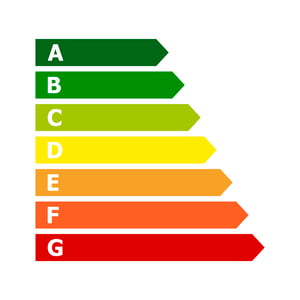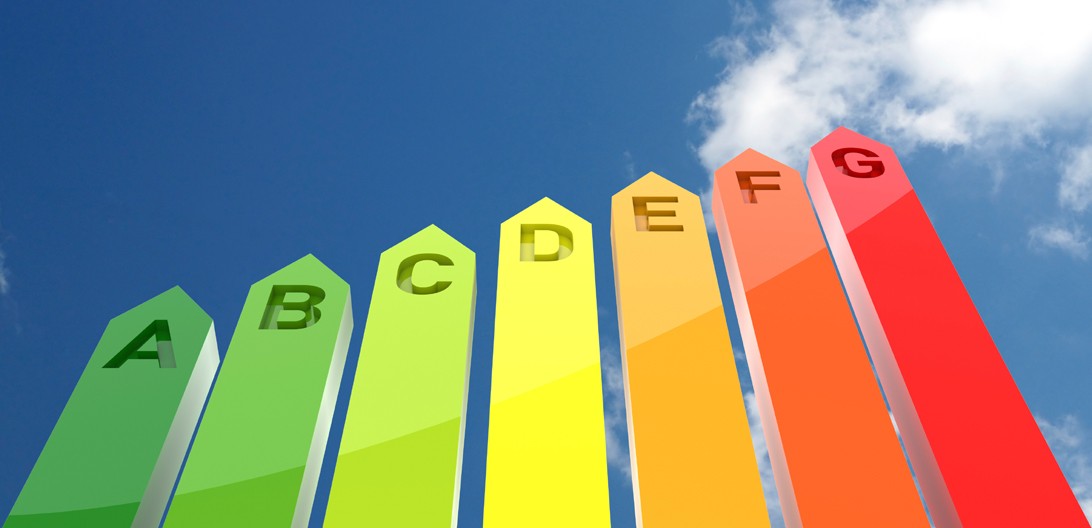Energy ratings for homes are a basic, and also mandatory, tool to provide information about the energy efficiency of a building, home, or premises. In this article, we explain the key concepts of the energy certification process, as well as the difference between each of the rating letters and how to correctly interpret the different ratings.
What is the energy rating? Certificate and label
 The energy rating, according to the ICAEN, is the result of calculating the energy use required to meet the energy demand of a building under normal operating and occupant conditions.
The energy rating, according to the ICAEN, is the result of calculating the energy use required to meet the energy demand of a building under normal operating and occupant conditions.
Through this process, a rating is assigned ranging from letter A (the most efficient) to letter G (the least efficient), based on the energy use and CO2 emissions of the building compared to a baseline building of similar type and location.
Energy certification is the procedure by which an energy rating is granted in the form of an energy efficiency certificate and label.
- The energy certificate is a document that confirms the conformity of the energy rating obtained.
- The energy label is the label indicating the level of energy efficiency achieved by the building or its parts.
The main objective of the energy certification is to provide useful information to all those who wish to buy, rent, renovate, or expand a home, as it shows the energy characteristics of the same. It is also useful for building owners who must pass the Technical Building Inspection (ITE). Energy certificates are also a document that is taken into account when applying for green mortgages, as well as most financing lines.
Energy certification also plays a key role in the development of nZEB or nearly zero-energy buildings, as it will be the document that proves their energy efficiency.
Energy certification process
To begin to explain the energy certification process for a building, we should know that the person responsible for requesting the certificate will be the owner of the building, home or premises to be certified, or the developer of the new construction building.
It is also important to know that the energy efficiency certificate and label is valid for 10 years from the date of issue, except when the energy rating for emissions or for non-renewable primary energy is a G, then the maximum validity is 5 years.
In Catalonia, the energy rating process is centralized in ICAEN, the Catalan Institute of Energy. The certification process begins with a visit from a certifier technician to the building, who evaluates its energy performance, obtains the certification, and registers it. Subsequently, the ICAEN issues the energy label, which the technician finally delivers along with the certificate to the owner.
To calculate the energy rating of a building or dwelling, the following 5 aspects are considered:
- The applicable building regulations.
- The climate zone in which the building is located. This factor influences the energy demand of the building and, therefore, its consumption and final rating. The Technical Building Code classifies climate zones based on the severity of the winter climate, using letters from A (less severe climatic conditions) to E, and according to summer conditions, using numbers from 1 (less severe climatic conditions) to 4.
- The characteristics of the envelope of the building, including facades, roofs, windows, doors, sun protection, etc.
- Facilities such as HVAC systems and domestic hot water generation. In the case of commercial buildings, lighting is also considered.
- The presence of facilities with renewable energy sources, such as solar thermal, photovoltaic solar energy, biomass, aerothermal, geothermal, and others.
What information does the certificate and the energy label contain?
The energy certificate for a newly constructed building shall include the identification of the building, the method used to determine the energy efficiency rating, the regulations applicable at the time of construction, a description of the energy characteristics of the building and the energy efficiency rating obtained.
In the case of a certification of an existing building, the energy certificate shall contain recommendations for improving the rating, a description of the tests and verifications carried out by the certifier and compliance with the environmental requirements imposed on the thermal facilities.
As far as the energy labels are concerned, the information they contain is as follows:

Energy label sample. Source: ICAEN
Differences in energy consumption and savings between the different letters
As we mentioned earlier, depending on the energy efficiency of the building or home, it will receive a letter from A to G. The difference in energy values between one letter and another is as follows:
| Primary energy rating (EP) | Average consumption EP CEE (kWh/m²-year) | Average consumption EP (kWh/m²-year) | Savings compared to previous (%) | Savings compared to G (%) |
| A | 33.80 | 56 | 26% | 89% |
| B | 45.94 | 77 | 36% | 85% |
| C | 71.57 | 119 | 21% | 77% |
| D | 91.10 | 152 | 39% | 71% |
| E | 149.14 | 249 | 31% | 52% |
| F | 215.83 | 360 | 30% | 30% |
| G | 309.56 | 516 | 0% | 0% |
Summary table of energy expenses and primary energy use for each letter. Source: ICAEN
In conclusion, the energy rating is a fundamental tool to know the energy efficiency of a building, dwelling or premises. Additionally, energy labels allow for the quick and easy identification of the energy efficiency level of a building, which facilitates decision-making in the purchase, rental, or renovation of a home.


